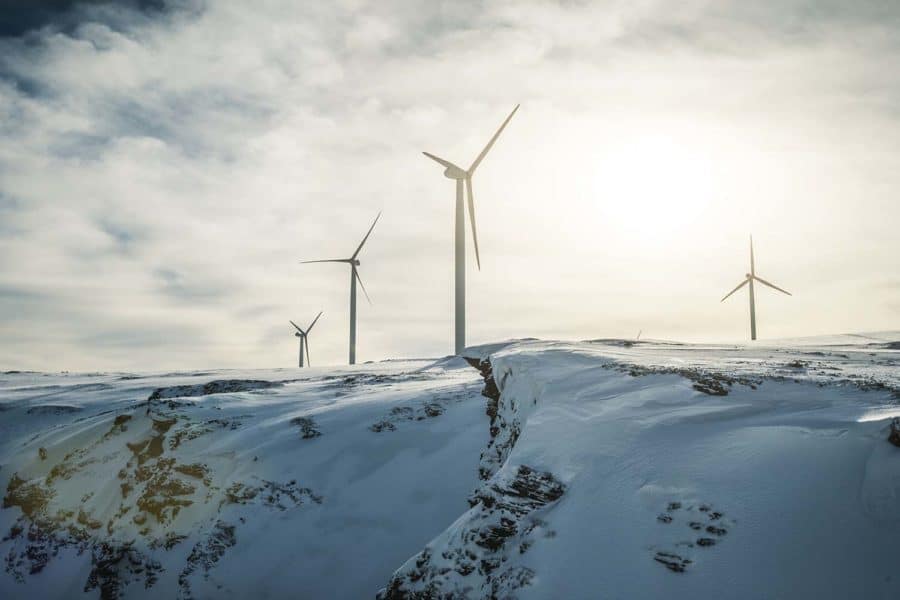In response to the recent freeze-inspired power outages in Texas, some politicians blamed the historic blackouts on wind turbines. The dubious, and largely dismissed, claims nevertheless spotlighted an intriguing fact: Texas, the land made famous by oil derricks and wildcatters, now gets a significant portion of its electricity from clean, renewable sources, most notably wind, but also from water and solar – a troika of sustainability known collectively as WWS.
“Texas gets about 20 percent of its electricity from wind alone,” says Mark Z. Jacobson, a professor of civil and environmental engineering at Stanford University and senior fellow at the Stanford Woods Institute for the Environment, who is author of a new study appearing in the journal Smart Energy looking at the future of smart grids.
Jacobson used computer models to show that wind turbines, averaged over large regions, actually ramp up their power during cold snaps, when demand for home and business heating is the greatest.
Furthermore, he concludes that wind – when combined with solar and water power, various energy storage systems and incentives for people to shift the time of some of their electricity use – could meet not only all electricity needs worldwide, but all energy demand in total, every minute of such crises.
Jacobson’s research investigated the ability of low-cost networks of renewable sources to meet demand worldwide, including in the United States, through the coldest of times so as to avoid blackouts. In particular, he wanted to answer a critical question: Can renewables do it all through the worst weather? According to his model, there is a direct connection between cold weather and wind power output. That is, winds tend to increase as the weather grows colder, precisely as demand for heat increases. Jacobson says that wind generation doesn’t simply hold its own through the coldest days, but actually rises to the moment when it is needed most. As the weather turns coldest, wind heats up.
Applying those findings to the real world, Jacobson thinks that, had all of the wind turbines in Texas been properly winterized, or protected from extreme cold, during the February 2021 freeze, they would have provided critical power to Texans throughout the cold snap and helped to prevent blackouts from occurring.
The study also investigated issues revolving around output stability. Winds don’t blow continuously, and cloud cover and nightfall limit the reliability of solar power. But according to Jacobson, wind and solar output are, in fact, correlated in an inverse and advantageous way. On the whole, when the wind is not blowing, the sun is usually shining during the day. Conversely, at times when the sun’s rays are blocked by storm cloud cover, winds tend to pick up, sending the turbines spinning.
Jacobson’s models show that, when averaged over a large area, wind and solar energy generation are complementary to one another during the day. One fills in when the other is lagging.
In the last part of his paper, Jacobson tackles what may be the biggest lingering concern about renewables, whether they can singularly meet total global demand in the coldest or hottest weather. The answer to this question gets to the heart of whether renewables might someday prove reliable enough to supplant fossil fuels altogether.
To answer this question, Jacobson considered 24 large renewable-only (WWS) grid regions across 143 nations throughout the world. He found low-cost solutions everywhere he looked. In large cold regions, such as in Canada, Russia, Europe, the United States and China, the increased demand for heating was frequently accompanied by rising wind energy output. In most other regions, only moderate correlations were found, but they were still enough to meet demand.
The findings have implications not only for energy security but also for climate-change mitigation strategies and public health. Seven million people, including about 78,000 in the United States, die each year from air pollution largely the result of fossil fuel consumption, Jacobson points out in the paper. These deaths can be avoided by transitioning to WWS energy.
“In most climates, these models shows that wind energy can help meet rising seasonal heat demand, even through the coldest of times, and it can do it while reducing the cost of energy, saving people’s lives and creating millions more jobs than lost worldwide,” Jacobson said.
To read all stories about Stanford science, subscribe to the biweekly Stanford Science Digest.
Media Contacts
Mark Jacobson, Stanford School of Engineering: jacobson@stanford.edu, (650) 723-6836
If our reporting has informed or inspired you, please consider making a donation. Every contribution, no matter the size, empowers us to continue delivering accurate, engaging, and trustworthy science and medical news. Independent journalism requires time, effort, and resources—your support ensures we can keep uncovering the stories that matter most to you.
Join us in making knowledge accessible and impactful. Thank you for standing with us!

